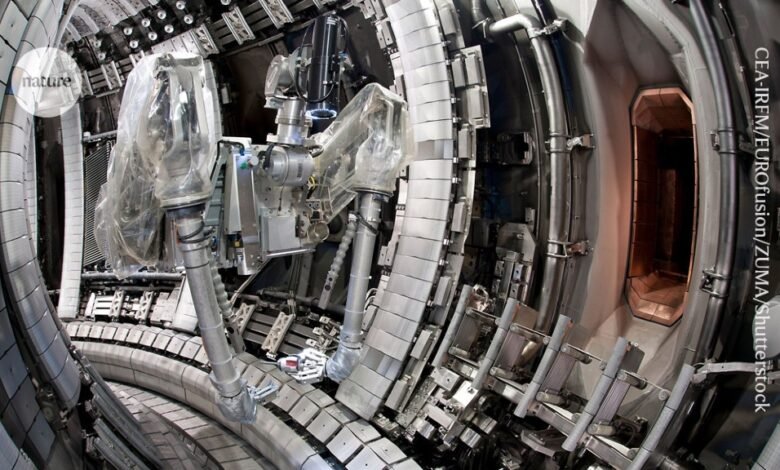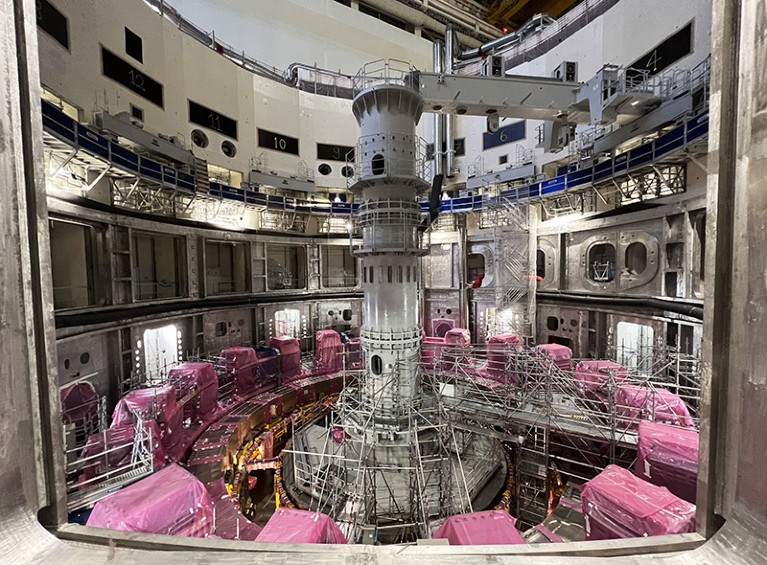

The metal tiles lining the inside cavity of the Joint European Torus are irradiated with tritium, radioactive isotope of hydrogen.Credit: CEA-IRFM/EUROfusion/ZUMA Press Wire/Shutterstock
Scientists have begun to decommission one of the world’s foremost nuclear-fusion reactors, 40 years after it began operations. Researchers will study the 17-year process of dismantling the Joint European Torus (JET) near Oxford, UK, in unprecedented detail — and use the knowledge to make sure future fusion power plants are safe and financially viable.
“We are starting to think seriously about a fusion power plant,” says Rob Buckingham, who leads on decommissioning for the UK Atomic Energy Authority (UKAEA), which oversees JET. “This means thinking about the whole plant life cycle.”
Harnessing the fusion of atoms — the process that powers the Sun — could provide humans with a near-limitless source of clean energy. Creating the conditions for fusion in power plants and exploiting the resulting energy will require complex engineering that hasn’t yet been proved, meaning that commercial fusion power is still many decades away.
But researchers are pushing ahead with designs for the first commercial reactors as excitement about fusion grows. In 2022, JET smashed the record for the amount of energy created through fusion. And the US National Ignition Facility (NIF) in Livermore, California — the flagship US fusion facility — now routinely generates more energy from a fusion reaction than was put in. The NIF calculations do not include the entire energy requirements of running the facility, which fusion plants would need to exceed to truly ‘break even’, but physicists have celebrated the milestones.
Fuel remnants
JET is important because the facility is a test bed for ITER, a US$22-billion fusion reactor being built near Saint-Paul-lez-Durance, France, which aims to prove the feasibility of fusion as an energy source in the 2030s. Jet has informed decisions on what materials to build ITER with, the fuel it will use, and it has been crucial to predicting how the bigger experiment will behave.
The thorniest part of decommissioning the JET site will be dealing with its radioactive components. The process of fusion does not leave waste that is radioactive for millennia, unlike nuclear fission, which powers today’s nuclear reactors. But JET is among the tiny number of experiments worldwide that have used significant amounts of tritium, a radioactive isotope of hydrogen. Tritium, which will be used as a fuel in future fusion plants including ITER, has a half-life of 12.3 years, and its radiation, alongside the high-energy particles released during fusion, can leave components radioactive for decades.
Decommissioning a fusion experiment doesn’t have to mean “bulldozing everything within sight into rubble and not letting anyone near the site for ages”, says Anne White, a plasma physicist at the Massachusetts Institute of Technology in Cambridge. Instead, engineers’ priorities will be to reuse and recycle parts. This will include removing tritium where possible, says Buckingham. This reduces radioactivity and allows tritium to be reused as fuel. “The sustainable recycling of this scarce resource makes economic sense,” he says.

The tokamak pit of ITER, the world’s largest fusion experiment, being built in southern France.Credit: Xinhua/Shutterstock
Ultimately, physicists will use the knowledge gained from JET’s decommissioning to improve how they embed recycling into the design of the Spherical Tokamak for Energy Production (STEP), a prototype commercial reactor being planned in Britain. The information will also shape future regulation, he says.
Radioactive doughnut
JET and ITER are both ‘tokamak’ reactors, which confine gas in their doughnut-shaped cavities. JET uses magnets to squeeze a plasma of hydrogen isotopes, ten times hotter than the Sun, until the nuclei fuse. The last time the fusion community decommissioned a comparable device was in 1997, when the Tokamak Fusion Test Reactor at Princeton Plasma Physics Laboratory in New Jersey shut down. Many parts, such as the equipment for injecting hot beams of gas into the reactor, were reused, as was the site itself. But the tokamak had to be filled with concrete, cut up and buried.
JET scientists hope to leave little overall waste. The main challenge, says Buckingham, is to understand where the tritium is and to remove it from materials, including from metal tiles that line the inside of the tokamak. JET engineers will use a newly refurbished robotic system to remove sample tiles for analysis. And they will use remotely operated lasers to measure how much tritium is in samples that remain inside the experiment. Like hydrogen, tritium is a gas that “penetrates all materials, and we need to know exactly how deep the tritium has penetrated”, says Buckingham.
Studies at JET this year will recover and analyse 60 wall tiles — the first of more than 4,000 components. “We can use this information to move from lab-scale research to industrial-scale processes, to detritiate the many tonnes of tiles and components which will be removed from JET over the next few years,” he says.
Detritiation nation
To extract the tritium from metals, engineers will heat the components in a furnace before capturing the released isotope in water. Tritium can be removed from water and turned back into fuel; leftover materials become low-level waste, the same classification given to radioactive waste made by universities and hospitals. Variations on this process are being tested for other materials, including resins and plastics.
JET researchers are exploring how to dispose of the low-level waste, as well as the much smaller amount of intermediate-level radioactive waste — in which nuclear decay occurs more frequently. Options for those remains include re-treating the waste, removing it to special disposal sites or storing it until it decays to lower levels of radioactivity. Some unaffected parts of JET, such as diagnostic and test equipment, have already been repurposed in
fusion experiments in France, Italy and Canada.
In its final experiments last December, JET went out with a bang. Scientists explored inverting the shape of the plasma in a way that might more readily confine heat. They also deliberately damaged the facility by sending a high-energy beam of ‘runaway’ electrons — produced when plasma is disrupted — careering into the reactor’s inner wall.
“Analysis of the damage, after the machine is opened up, will provide useful data to test the detailed predictions,” says Joelle Mailloux, who leads the scientific programme at JET.
Source link




